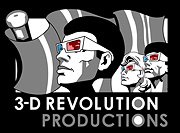Red-Blue bad?

Lucas, Zemeckis, Rodriguez & Cameron
Recently, as you probably well know, James Cameron has been doing the rounds promoting polarized DLP projection and twin-camera HD 3-D shooting as the way forward for the 3-D film industry. It is a very valid point that the polarized Real-D projection solution is a massive step forward for 3-D film and its chances of survival (for longer than two years). Because of the standardisation of Real-D within the DLP architecture, combined with the fact that Real-D projection can’t be screwed up by projectionists, 3-D cinema has now got a fighting chance to not hurt the audience’s eyes and thus stick around for longer – as long as the quality of 3-D films stays above abysmal quality levels.
But Cameron takes the argument a step further by making the attending audience shout: “Red-blue, bad!” But why? There is nothing wrong with anaglyph 3-D. It’s been around as long as stereoscopic film itself has and has never gone away because of its versatility, ease of use and cheapness. In fact, Sony Pictures Imageworks (SPI) still uses it for their 3-D monitor previewing.
Anaglyph 3D image of 'The Incredible Invasion...'
A big point that people make nowadays about anaglyph 3-D is that they think it causes discomfort and headaches. True, it is not an ideal format in terms of colour and separation, and your brain will attempt to compensate for the colour filters by turning your vision blue and red, inversely to the glasses. But it is misuse of 3-D, not the presentation format, that causes real headaches.
It’s tempting to think that the progress of technology has solved all problems with 3-D film production and screening. It hasn’t because it can’t. The biggest problems with 3-D filming stem from the physical limitations of what the eye and brain can do and subsequently how far 3-D cameras can be separated (the interocular distance), rotated inward (convergence) and how close they can be to the subject. No technology can solve breaches of human physical ability and a painful 3-D experience must almost always be blamed on poorly thought out and executed 3-D direction and camera work.
The cast of Jaws 3-D argues over which 3-D lens adapter to use
The biggest issue is of course the proven fact that one bad 3-D presentation can ruin it for the rest. People will happily equate the pleasure of 3-D with that of the last presentation they have seen and if that presentation was a poor one, that audience will label 3-D bad overall. It’s not fair, but that’s the way 3-D has been treated in 3-D film’s rise and decline of 1953-54 and 1983-84. So it’s time to stop pointing fingers and start shooting good 3-D, with a proper story that is enhanced through the stereoscopic visuals!![]()
![]()
![]()
![]()
![]()
![]()
![]()
![]()
![]()
![]()
![]()
![]()




